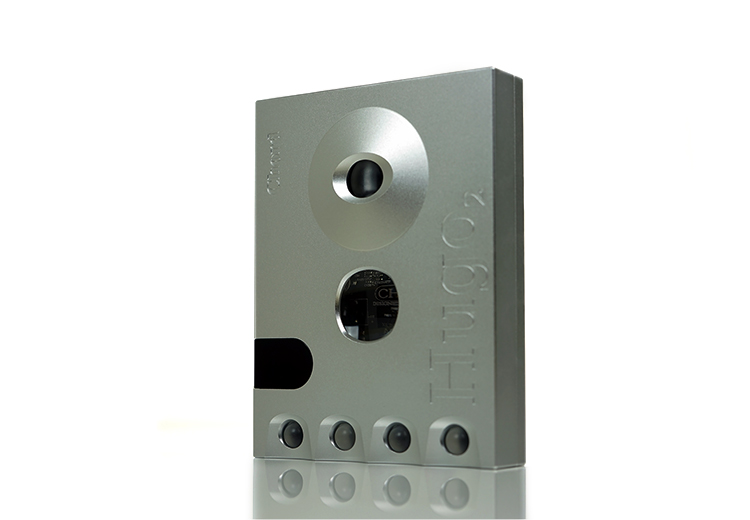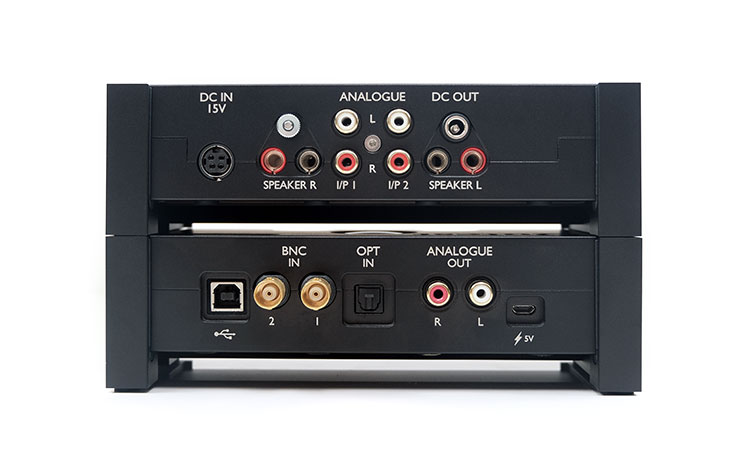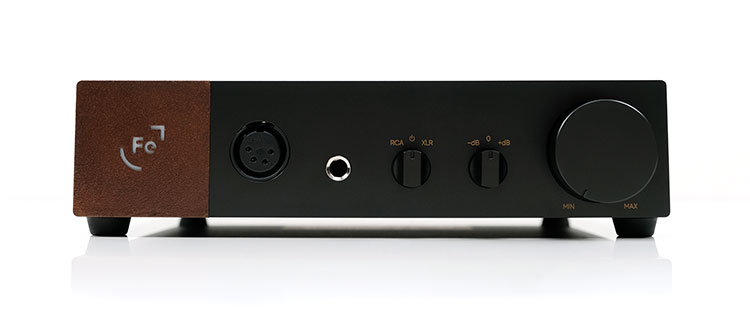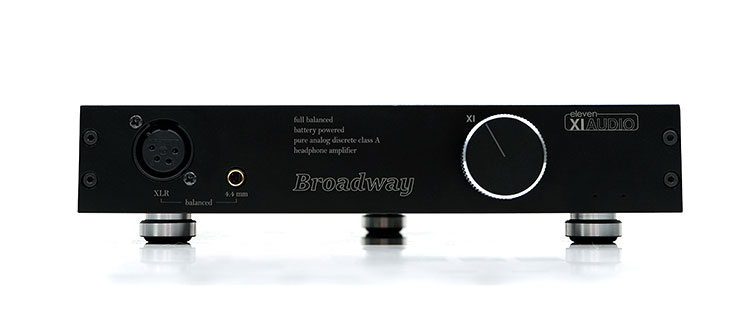Select Comparisons
All comparisons were completed with the Qutest and Hugo as our selected sources with the Abyss Headphones Diana TC, Meze Elite, and the Empire Ears Odin as our chosen headgear.
Chord Electronics Hugo 2
£1,800
It has almost been 5 years since the launch of the Hugo 2 and it is still going strong to this day as Chord TOTL portable DAC & Amplifier and our award winner in 2017.
Technical
Technically, you can link the Hugo 2 to the Anni and run it as a source and price-wise it is only marginally cheaper than the Anni and the Qutest combined.
The big user-case difference, however, is the fact that the Hugo 2 is battery driven and therefore portable with the ability to link in with the 2GO for wireless connectivity. Whereas the Anni, and the Qutest, are 100% DC-powered.
Nevertheless, the Hugo 2 is a very capable amplifier in its own right but also one which has a very different topology to the Anni. Inside, you have a solid-state Class A design as opposed to the Anni’s Class AB dual feed-forward amplification circuit.
As you would expect from Chord, both amplification implementations are single-ended designs with both offering 3.5mm and 6.35mm PO TRS outputs. However, the Hugo 2 amplifier is a closed-circuit meaning PO output only.
You do get analog outs so preamping or powering active speakers is possible but it will not directly power passive speakers in the same manner as the Anni.
Output power for headphones is also shaped quite differently. The Hugo 2’s Class offers 95mW into a 300Ω load compared to much more from the Anni at 500mW. Anni is better equipped to deliver more power to more demanding headphones.
The Anni can offer up to 10W into a lower 8Ω peak rating compared to just 1W from the Hugo 2. At 32Ω that drops to 740mW compared to 3W from the Anni on the same load.
Design
There is a lot of commonality in the design language of these two devices with both CNC machines in a very similar fashion from aluminum and both making heavy use of Chord’s polycarbonate orbs for controls and status.
In terms of their respective form factor, however, they are quite different. Again, this comes down to the intended user scenario and target market with the Hugo 2 pitched as a large portable device but still desktop compatible. It is quite a bit smaller and half the weight of the desktop-only Anni.
Because of the DAC inside the Hugo 2, the control system is more complex with a steeper learning curve compared to the Anni which is very easy to operate in the initial stages.
A fine example is the volume control with the Hugo 2 more dialed into the orb ethos using a large color-changing controllable polycarbonate orb whereas the Anni has a more familiar potentiometer system.
The color system on the Hugo 2 volume is harder to remember but its level of accuracy and micro-control for attenuation is excellent. The Anni pot is much simpler to use, easier to remember but slightly less accurate with a bit of leeway in movement before the volume responds.
The last is really heat management. The Hugo 2 can get warm when in use though most mask it with its associated leather case when being handled. It’s nothing hugely noticeable when in use as a result.
The Anni gets a lot warmer, and its internal fan is a bit noisier also. Unless you are right beside the Anni listening to very quiet music on headphones, I still not sure if that’s going to be an issue.
Combined Performance
We will start first with the combined systems, aka Qutest/Anni versus the Hugo 2 DAC and amp using the Meze Elite. The desktop combo for me is a little more rambunctious or exuberant in its delivery whereas the Hugo 2 is a more linear, controlled, and pristine sound signature.
Via the Elite, the low-end of the Anni/Qutest has a bit more sub-bass presence and a stronger mid-bass bump alongside it. The Hugo 2 is more neutral in its bass quantity with quite a linear tuning. It is tight and clean with better layering but if you want some weight and slam then the desktop pairing is the more apt of the two.
The mids are a different kettle of fish. The Hugo 2 is open, expressive, complex, and very detail-driven. With the Elite, it also sounds very accurate with a beautiful harmonic balance and vocal imaging that is more to the fore.
The Anni/Qutest combo is a little bit cleaner, harder-edged sounding but not overly so. It still has a very nice overtone and is very listenable with the Elite. However, the degree of instrumental separation and just how holographic the staging becomes is comparatively diminished. Vocals fall back a little also as do the staging width and height.
Standalone Performance
For this, we fed the Hugo 2 DAC into the Anni to best judge the performance of both amplifiers in their own right. With both sharing the same DAC the differences between the two amps become a lot clearer.
The general coloration or instrumental timbre is now a lot closer to each other with only some minor variances. The Anni sounds smoother with an improved harmonic balance through the mids and highs when paired with the Elite. Vocal performances also have a little bit of a softer leading edge compared to the excitable Qutest feeding the Anni.
However, some technical aspects do remain even with a shared DAC. For a start, the Anni still delivers more sub-bass body and presence and of the two offers a stronger bass fundamental, and in part, a better mid-bass punch. Bass guitar slaps, drum kicks, and low-end synth notes sound fuller and more physical in their delivery.
The Hugo 2 mids still offer a more open quality with a more precise and detailed imaging performance as well as improved staging width. It is still the more holographic sounding of the two amplifiers with the Meze Elite despite the DAC change.
Also, some of the spatial cues on the extreme edges of the Hugo 2 soundstage or perhaps slightly higher up beyond the upper mids dig out a tiny bit more upper harmonic presence making them a little easier to pick out.
Ferrum OOR
$1995
The OOR was launched and reviewed by us just last year and is also one of our award winners from 2021 alongside their HYPSOS PSU module.
Technical
Both amplifiers use a Class AB topology but with their own distinct tweaks so to speak. The Anni benefits from a trickle-down of Chord’s high-end ULTIMA technology with its dual-feed forward error-correction implementation. Whereas the OOR emphasizes its discreet design meaning zero integrated circuits and using transistors instead.
The Anni is also a single-ended amplifier whereas the OOR has a fully balanced topology from input to output. There is no direct-to-speaker compatibility with the OOR, however, it does have balanced and SE pre-amp capability making it a better fit to feed into power amplifiers.
Of the two for headphones usage, the OOR is the more powerful of the two when going balanced. It is capable of up to 8W into 60Ω with the Anni offering 3W into 32Ω and likely lower for 60Ω.
Of course, the Anni does not offer balanced outputs so switching to single-ended is a lot more competitive with a peak of 2W into 60Ω for the OOR which is a similar ballpark for the Anni.
On paper, however, the Anni seems to offer a potentially lower noise floor at -110dB compared to -105dB from the OOR though it is not known if they used the same weighting to achieve that score.
Both amplifiers offer gain switch controls with the OOR allowing for up to 6 variations. 3 for balanced at -4 dB, +6 dB, or +16 dB and 3 different values for unbalanced at -10 dB, 0 dB, and +10 dB. The Anni offers two levels that sit somewhere on the far right of the OOR range between approximately +5db and +13dB but are only for the speaker output.
Power
One final, but very important technical observation regarding power. It is sort of reversed here with the Anni able to feed a DC output via a converter kit to power both the Qutest DAC and Huei phono stage at the same time if stacked and in use.
The OOR has its own DC input but with the HYPSOS dedicated PSU, you do not need it. Instead, you can use a Weipu DC coupler and feed very clean DC to the OOR. More than that you can tweak it producing some nuanced tuning changes in the OOR output.
Design
Both designs are very slickly presented but for me, the OOR is more of that industrial boxy form factor with a creative and slick paint job whereas the Anni design is more distinct right from the cutting to the finishing.
Certainly, the Anni form factor is smaller, also it’s lighter by almost 1.2kg so if the OOR works for desktops then the Anni is going to be perfect for even tighter spaces. You can stack both amplifiers with related products in each company’s respective product catalogs. The OOR is most at home with the HYPSOS whereas the Anni looks great with the Qutest and the Huei.
There is no dedicated DAC yet for the OOR but you can triple stack with their integrated ERCO and the HYPSOS and use it that way. The overall cost though is a fair bit higher than the triple stack Qutest range. By the way, the HYPSOS does have a configuration to power the Qutest so the two product lines are not mutually exclusive.
I have to give the edge to the OOR ease of use for controls. Everything is clearly labeled and more traditional in their understanding of what they do. Also, the potentiometer is more stable and accurate compared to the Anni pot.
Both amps will give you two analog input options. If you want balanced OOR is the better choice, if you want to directly power a small set of speakers the Anni is the only choice.
Purely a personal observation, but two SE inputs on the Anni rather than one balanced and one SE on the OOR can have some benefits. For example, if you want to compare and contrast source performances similar input voltage parameters make for easier comparisons.
Performance
Connected to the Qutest I was split on these two amplifiers in terms of preference. On a technical level, the OOR is the better performer and the more revealing of the two also, allowing the Qutest’s own thing to shine through in a very recognizable manner.
It is also the more capable amp in terms of power and dynamic range with the Diana TC/OOR sounding the more articulate and resolving of the two pairings.
However, the timbral match of the Qutest/OOR with the Diana TC left me a bit cold compared to the Anni’s slightly warmer, fuller, and definitely punchier sound signature. It is quite neutral to the point of it being the perfect representation of ‘gain on a wire’.
The Diana TC/Anni pairing has more character, a fun listen you could say. I can hear clearly it is not quite as revealing or as open but it compensates with that more endearing and energetic interpretation of the Qutest’s clean tuning.
The OOR does need the right DAC behind for headphone synergy but it can handle a very wide range of headphones to a very high level. Whereas the Anni seems more forgiving with its closer, more intimate staging quality and stronger low-end. Its softer leading edges on vocal and instrumental notes make it more of a relaxed listening experience.
XI Audio Broadway
$2,299
A bit of an underdog in some ways, however, the Broadway amplifier that we reviewed in late 2019 still gets some heavy rotation in our office to this day.
Technical
The Broadway sample we have here is a discreetly designed balanced Class A topology as opposed to Anni’s single-ended Class AB with a dual-feed forward error-correction design. The Broadway, however, is a pure headphone amplifier so unlike the Anni it has no ability to directly drive speakers, though neither has a pre-amp.
The Broadway shoots for good but not huge power for headphones at 1.5W into a 32Ω load, which is a lot less than the Anni SE performance at 3W into the same load.
For a few bucks less you can also buy an SE version of the Broadway, (Broadway S) which is still a Class A design but specifically for low impedance headphones. If you opt for a like-for-like Broadway S or Anni, then the output power drops considerably to 800mW on a 16Ω which is a lot lower than the capability of the Anni on a 32Ω load.
Both amplifiers do offer a two-stage gain function with similar dB gaps between both. The Broadway will give you a high gain of 3.2dB and a low gain of -7.5dB or about a 10.7dB swing whereas the Anni has roughly an 8-9dB swing with a low gain of around +5dB and the high gain is a shade over 13dB but only for the speaker output.
Power
Broadway’s power management is a fairly unique feature. It can run either via DC or, if you open it up, run from 4 x 18650 batteries making it somewhat of a portable amplifier but also supplying a potentially cleaner source of energy.
Though desktop chained, the Anni does offer a DC out to allow you to power the Qutest and the Huei without adding additional bricks to what is a very compact and light stack.
Design
Chord has an edge here in almost every aspect of the design save for the potentiometer of the Broadway which I consider to be more accurate and smoother to operate compared to the smaller Anni alternative.
The Broadway is fairly DIY looking with a very industrial plate-style box design and sharp edging. Power is controlled by a stiff mechanical switch to the rear and its gain system via dip switches on the base of the panel.
I call it old school but very robust. Then again, the Chord design is also known for being supremely robust also and still has a much more refined aesthetic as well as a more complex CNC-machined aluminum housing.
The form factor of Broadway is bigger and more traditional in its dimensions. However, though heavier it’s not that heavy at around 1.1kg including the 4 batteries. If you take them out and run pure DC input then it’s actually a lot closer to the weight of the Anni.
I/O is more complex on the Anni with more options including speaker posts and up to 2 SE analog inputs as well as a DC out to drive the Qutest and the Huei if required.
The Broadway is just a single set of inputs, in this case balanced, and in the S model dual RCA SE options. However, that 4.4mm output on the balanced model is a very attractive PO for modern audiophiles.
Performance
Between the two in terms of driving both efficient and more demanding headphones, there is not a huge amount of difference despite the Broadway sample being balanced only.
Both the Diana TC and the Elite sounded similar in terms of dynamic range and resolution with the only real difference coming from the degree of channel separation being a bit stronger on the Broadway creating a little more perceived staging width, (and height).
The Broadway had a bit more treble extension and presence compared to the Anni which gave those distant upper mids to treble spatial cues a bit of a lift creating a sweeter lighter overtone through the mids and higher frequencies instruments.
The Anni delivered a more rounded coloration with both our chosen headphones. It sounded smoother and fuller but with slightly less sweet sparkle on the highs. Instead, you get more slam, depth, and body in the lows to lower mids instruments and a more forward male vocal presence with the Anni pairings.
I would say the Anni delivers a more center-focused image, at least with the Qutest as your source. It does well to translate the slam from the Qutest low-end quite well but does not really push as hard in the highs as more neutral amplifiers might.
The Broadway is not exactly neutral but its imaging and staging are more linear with a bit more openness and speed in the mids and an airier top-end. Its low-end is tight but not as weighty so slightly less on the ‘PRaT pedal’ so to speak giving it that lighter-sounding coloration.
Our Verdict
The Chord Electronics Anni amplifier is a beautifully designed small amplifier with a surprisingly big and joyful sound signature. It has enough power to drive a wide range of headphones so those concerned about being single-ended only should rest at ease.
It’s almost the perfect complement to the Qutest DAC. Not just its looks and match form factor but also leveraging the Qutest’s excitable tuning to produce satisfying levels of slam but doing well to keep that treble very natural sounding.
Drawbacks? Not so many but I would have liked to have seen a gain switch applicable to the headphone output and made more compatible with sensitive IEMs. Also, whilst the power is plentiful for most, it will still come up a bit short for headphones with very low sensitivity levels such as the Diana TC and the Susvara.
Aside from that, I think Chord has got both the pricing and positioning of the Anni spot on. It’s a great little desktop amp for the modern audiophile and one that I am looking forward to pairing with our soon-to-be-reviewed Huei phono stage.
Chord Electronics Anni Specifications
- Power Output: 10 W 8 ohms
- THD: 0.02%
- Signal to Noise: -92 dB
- Noise floor: -110 dB
- Frequency response: 5 Hz – 60 Khz (-3 dB)
- Dimensions: 160 mm (W) x 42.50 (H) mm x 96.60 (D) mm
- Weight: 625 g






